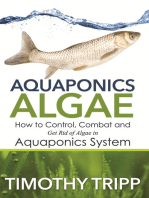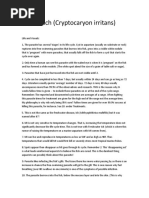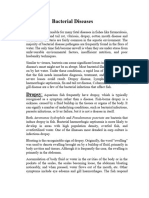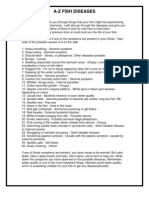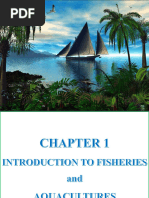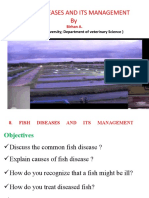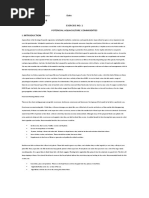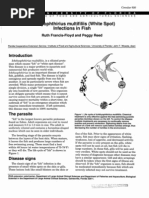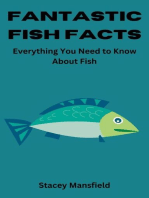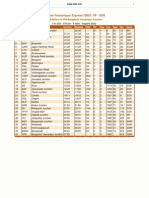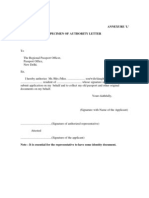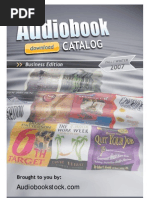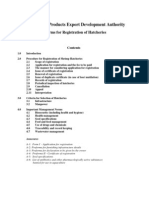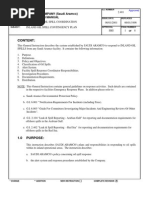Diagnosis and Treatment of "Ich" or White Spot Disease in Fish
Diagnosis and Treatment of "Ich" or White Spot Disease in Fish
Uploaded by
prtmCopyright:
Available Formats
Diagnosis and Treatment of "Ich" or White Spot Disease in Fish
Diagnosis and Treatment of "Ich" or White Spot Disease in Fish
Uploaded by
prtmOriginal Title
Copyright
Available Formats
Share this document
Did you find this document useful?
Is this content inappropriate?
Copyright:
Available Formats
Diagnosis and Treatment of "Ich" or White Spot Disease in Fish
Diagnosis and Treatment of "Ich" or White Spot Disease in Fish
Uploaded by
prtmCopyright:
Available Formats
AQUACULTURE EXTENSION Illinois - Indiana Sea Grant Program
Sea Grant # IL-IN-SG-E90-2
Fact Sheet AS- 459
Diagnosis and Treatment of Ich or White Spot Disease in Fish
DISEASES
LaDon Swann
Illinois-Indiana Sea Grant Program
Scott Fitzgerald, D. V.M.
Animal Disease Diagnostic Laboratory
Purdue University
Purdue University
Description
Ich or white spot disease is the name commonly given to the external protozoan, Ichthyophthirius multifiliis. It is probably the most serious disease of channel catfish, and is commonly seen in other warmwater and coolwater species of farmed fish including hybrid striped bass. Ich is the only protozoan parasite that can be seen by the naked eye. Microscopic examination reveals a ciliated protozoan that has a horseshoe shaped micronucleus. Mature specimens range in size from 0.5- 1.5 mm in diameter.
fish and becomes a free-swimming form that settles to the bottom or fastens itself to the sides of the pond or tank. There it attaches to any suitable substrate, rocks, plants, tubing, etc. This cyst stage then undergoes a series of multiple divisions creating as many as 2,000 young protozoans called tomites. The length of time needed for these divisions is based on water temperature; at 77F the development of tomites may require only 12 hours, while at 50F it may take several months. After development of the tomites is complete, they emerge from the cyst as free-swimming theronts and seek a host to penetrate. After penetrating the fishs skin, the theronts are referred to as trophozites and the life cycle begins again. If the free-swimming theronts do not find a suitable host within 24 hours they die. The optimal water temperature for Ich is 68-75F. In warmwater fish cultures the disease is considered to be a fall-winter-and spring-occurring disease. Since the occurrence of the disease is most common in the spring, it is the opinion of some researchers that poor winter nutrition plays a role in the outbreak of the disease. This theory is in need of further research.
Symptoms
Symptoms of Ich include gray-white spots that give the fishs skin and fins the appearance of being sprinkled with salt. These granular white spots have a bumpy feel to the touch. Infection of the gills occurs before the skin and fins, and in species such as the golden shiner, the gills are usually the only infected organ. In the earlier stages, the fish may swim horizontally and rapidly rub or flash against solid objects in an attempt to free themselves of the parasites. Fish also may appear sluggish and lie on the bottom of the pond or tank. In catfish ponds, fish frequently rest near the edge of the water. In advanced cases, bloody tins are common, with a thick mucous layer covering the body.
Treatment
Treatment of the disease is difficult because the fish-inhabiting and encysted forms are resistant to treatment, Only the free-swimming forms are vulnerable to treatment. The best treatment is prevention, Incoming water sources should always be kept free of wild fish which may carry the
Life Cycle
The life cycle of Ich is complex. The mature parasite is found just under the skin of the fish and is visible as a white spot. Eventually, after spending 10-20 days (based on water temperature and resistance) under the skin of the fish, the adult leaves the
protozoan and infect the farmed species. Infected ponds, tanks, or raceways will become Ich-free if left without any fish for a period of Seven days with a water temperature of at last 68 oF. New fish should be quarantined for at least one week at 70F for warmwater species and two weeks at 60F for coldwater species. Such a quarantine allows the disease to manifest itself prior to being introduced to healthy fish. Contaminated boats, buckets, and nets may be disinfected with calcium hypochlorite 70% chlorine to prevent contamination of other ponds or tanks, Even with these precautions, outbreaks of Ich may still occur. Therefore, two categories of treatments, chemical and mechanical, arc discussed.
Using formalin in large ponds at a rate of 15-15 mg/l is effective in treating Ich but can be cost prohibitive, TwO to four applications, made on alternate days, should be used, with [he higher dosage being the most effectivce Formalin removes oxygen from the water, so it is critical to monitor oxygen levels during treatment and be prepared to supply supplemental aeration if levels drop below 5 mg/l. Potassium permanganate is sometimes used successfully to treat Ich. Treatment rates of 2 mg/l should be repeated on alternate days; two to four applications arc recommended. Success using Potassium permanganate is low.
Mechanical Chemical
Treatment of Ich with chemicals can be costly and time-consuming. It is important to test the chosen chemical on a small test group prior to performing any chemical treatment on entire ponds or tanks of fish. Copper sulfate is used at whatever concentration is safe in the existing water chemistry. Copper ions arc extrmemely toxic to fish and the degree of toxicity depends on the water hardness. In water with a hardness of 40-50 m milligrams/liter(mg/ 1), use less than 0.25 mg/l of copper sulfate. For water with a hardness of 50-90 mg/l use 0.5 mg/l. For hard water with a hardness value of between 100-200 mg/l use 1 mg/l. Treat on alternate days, with two to four applications neccessary. Regardless of water hardness, treatments should be reduced by one-half during the third, and fourth treatment. Probably the easiest treatment in indoor systems for Warmwater species is to raise. the water temperature to 85F for three weeks. Since Ich is a coolwatcr protozoan, raising the temperature will kill the freeswimming forms before they have a chance to reinfect the fish. A second method to mechanically treat fish applies to raceway culture or pond culture, where infected fish can be removed and placed in a raceway. This treatment involves increasing the flow rates as high as possible while still permitting the fish maintain their position in the raceway. The increased flow flushes away the free-swimming forms before they have a chance to settle to the bottom and attach.
NA 89 AA-D-SG058
NEW1/91 (.5M)
Cooperative Extension work in Agriculture and Home Economics, state Of Indiana, Purdue University and U.S. Department of Agriculture cooperating. H. A. Wadswoflh, Director, West Lafayette, IN. Issued in furtherance of the acts of May 8 and June 30, 1914. The Cooperative Extension Service of Purdue University is an affirmative action/equal opportunity institution.
You might also like
- Microbiology Nuts & BoltsDocument42 pagesMicrobiology Nuts & Boltsteena jacobNo ratings yet
- Tech Trends 2022 - DeloitteDocument128 pagesTech Trends 2022 - DeloitteJosé Vanderlei LeiteNo ratings yet
- 5 - Fish Health ManagementDocument51 pages5 - Fish Health ManagementJenny VillamorNo ratings yet
- Aquaponics Algae: How to Control, Combat and Get Rid of Algae in Aquaponics SystemFrom EverandAquaponics Algae: How to Control, Combat and Get Rid of Algae in Aquaponics SystemRating: 5 out of 5 stars5/5 (2)
- How To Treat Livebearer DiseaseDiseaseDocument4 pagesHow To Treat Livebearer DiseaseDiseasePieter SteenkampNo ratings yet
- Health Problem of Ornamental Fish in BangladeshDocument19 pagesHealth Problem of Ornamental Fish in BangladeshAbir WahidNo ratings yet
- OodiniumDocument6 pagesOodiniumJackAsNo ratings yet
- Marine Ich (Cryptocaryon Irritans)Document4 pagesMarine Ich (Cryptocaryon Irritans)kinamedeboNo ratings yet
- Diseases Parasites and Predators Management and ControlDocument7 pagesDiseases Parasites and Predators Management and ControlGeorge AtaherNo ratings yet
- White SpotDocument2 pagesWhite SpotAevry TanNo ratings yet
- A Common ParasiteDocument2 pagesA Common ParasiteAndrei BurneteNo ratings yet
- ChilodonellaDocument2 pagesChilodonellascribdphinNo ratings yet
- Effect of Light, Temperature and Salinity On The Growth of ARTEMIADocument8 pagesEffect of Light, Temperature and Salinity On The Growth of ARTEMIAinventionjournalsNo ratings yet
- T.L.E 10 Mortalities Mortality in Fish Production Ponds Has Been Considered An Parameter in Understanding The Dynamics ofDocument14 pagesT.L.E 10 Mortalities Mortality in Fish Production Ponds Has Been Considered An Parameter in Understanding The Dynamics ofManjiro SanoNo ratings yet
- Pen and CagesDocument40 pagesPen and Cagesshuvatheduva123123123No ratings yet
- Bacterial DiseaseDocument4 pagesBacterial DiseaseBhupesh KumarNo ratings yet
- Ornamental FishDocument8 pagesOrnamental FishAbubakar A ModibboNo ratings yet
- FP Handout1Document20 pagesFP Handout1tundagjulz39No ratings yet
- A-Z Fish DiseasesDocument22 pagesA-Z Fish DiseasesFiras AlSayyedNo ratings yet
- Common Fish DiseasesDocument5 pagesCommon Fish DiseasesAbhijit DuttaNo ratings yet
- IBPS AFO Fisheries Competative FactorDocument32 pagesIBPS AFO Fisheries Competative Factorreallabhishek.singhNo ratings yet
- IBPS AFO Fisheries Competative FactorDocument32 pagesIBPS AFO Fisheries Competative Factorreallabhishek.singhNo ratings yet
- Tynjuhbor Jyrwa 2nd Sem Crustacean Fish Disease Ppt.Document24 pagesTynjuhbor Jyrwa 2nd Sem Crustacean Fish Disease Ppt.waienstien27No ratings yet
- FAO Fisheries & Aquaculture - Hippocampus ComesDocument7 pagesFAO Fisheries & Aquaculture - Hippocampus Comesagudo64No ratings yet
- Leeches: What Is A Leech?Document2 pagesLeeches: What Is A Leech?Caleb VoosNo ratings yet
- Fisheries Reading Material 1 - 4 2023@RDocument139 pagesFisheries Reading Material 1 - 4 2023@Rmuluken olkamoNo ratings yet
- Carp PoxDocument2 pagesCarp PoxAnonymous ifPd3FMueNo ratings yet
- Fish Disease Lecture BDUDocument102 pagesFish Disease Lecture BDUaklilu mamoNo ratings yet
- Lecture Note Fish - Diseases BVSCDocument52 pagesLecture Note Fish - Diseases BVSCFira'ol BogalaNo ratings yet
- Fish50 Write UpDocument3 pagesFish50 Write UpSophia ManzanoNo ratings yet
- The Complete Aquarium Guide Fish, Plants, & Accessories For Your Aquarium (English)Document288 pagesThe Complete Aquarium Guide Fish, Plants, & Accessories For Your Aquarium (English)Nigel Tuke100% (1)
- Ajayiand Okoh 2014 JFEApublDocument6 pagesAjayiand Okoh 2014 JFEApublglendelcarla17No ratings yet
- Ichthyophthirius Multifiliis (White Spot) Infections in FishDocument1 pageIchthyophthirius Multifiliis (White Spot) Infections in FishMuhammad Ihsan MNo ratings yet
- The Problem and Its Setting: Glan IsDocument7 pagesThe Problem and Its Setting: Glan IsRogelio PontejoNo ratings yet
- Fish Health and DiseasesDocument27 pagesFish Health and DiseasesptsievccdNo ratings yet
- 04 Protozoan DiseasesDocument29 pages04 Protozoan DiseasesSantosh Bhandari50% (2)
- Prof 323 2ND Sem Module 2 1Document12 pagesProf 323 2ND Sem Module 2 1Reyjhon LumayalNo ratings yet
- Last YearDocument11 pagesLast YearBattlecruiser ScharnhorstNo ratings yet
- Managing A Healthy Tilapia OperationDocument3 pagesManaging A Healthy Tilapia OperationAquaponics100% (1)
- Josileen Jose - 2023 - Crab Culture - Course Manual Winter School On Mariculture TechnologiesDocument12 pagesJosileen Jose - 2023 - Crab Culture - Course Manual Winter School On Mariculture TechnologiesTriana DewiNo ratings yet
- Feeding CareDocument13 pagesFeeding CareAxel M. AyingNo ratings yet
- IdeasDocument7 pagesIdeasAxel M. AyingNo ratings yet
- Chanos Chanos or Commonly Known As Milkfish. It Is Known in The PhilippinesDocument3 pagesChanos Chanos or Commonly Known As Milkfish. It Is Known in The PhilippinesNathaniel CastasusNo ratings yet
- Essential Tropical Fish Species Guide: The simplified guide to identifying, selecting and caring for your tropical fishFrom EverandEssential Tropical Fish Species Guide: The simplified guide to identifying, selecting and caring for your tropical fishNo ratings yet
- The Coral Reef Aquarium: An Owner's Guide to a Happy Healthy FishFrom EverandThe Coral Reef Aquarium: An Owner's Guide to a Happy Healthy FishRating: 3 out of 5 stars3/5 (1)
- Freshwater Aquariums in Your LifeFrom EverandFreshwater Aquariums in Your LifeAmanda PisaniNo ratings yet
- Clownfish as pets. Clown Fish owners manual. Clownfish care, health and feeding all included.From EverandClownfish as pets. Clown Fish owners manual. Clownfish care, health and feeding all included.No ratings yet
- Seahorses as Pets. Seahorse Complete Owners Manual. Seahorse care, health, tank, costs and feeding.From EverandSeahorses as Pets. Seahorse Complete Owners Manual. Seahorse care, health, tank, costs and feeding.No ratings yet
- River Habitats for Coarse Fish: How Fish Use Rivers and How We Can Help ThemFrom EverandRiver Habitats for Coarse Fish: How Fish Use Rivers and How We Can Help ThemNo ratings yet
- Aquaponics Systems, Fish. Volume 6: Sistemas de acuaponíaFrom EverandAquaponics Systems, Fish. Volume 6: Sistemas de acuaponíaNo ratings yet
- Fantastic Fish Facts: Everything You Need to Know About FishFrom EverandFantastic Fish Facts: Everything You Need to Know About FishNo ratings yet
- GACP Trainers ManualDocument26 pagesGACP Trainers ManualprtmNo ratings yet
- Project Profile On Groundnut Oil and Oil Cake ManuafcuringDocument2 pagesProject Profile On Groundnut Oil and Oil Cake ManuafcuringprtmNo ratings yet
- WWW DeltapageDocument1 pageWWW DeltapageprtmNo ratings yet
- DesktopDocument7 pagesDesktopprtmNo ratings yet
- Tamil Nadu Fisheries University: Nagapattinam - 611 001Document2 pagesTamil Nadu Fisheries University: Nagapattinam - 611 001prtmNo ratings yet
- Pledge On The International Ozone DayDocument1 pagePledge On The International Ozone DayprtmNo ratings yet
- Apple - Ipod - Compare Ipod Models and Find The Right One For YouDocument3 pagesApple - Ipod - Compare Ipod Models and Find The Right One For YouprtmNo ratings yet
- IRI 12863 Howrah Yesvantapur ExpressDocument1 pageIRI 12863 Howrah Yesvantapur ExpressprtmNo ratings yet
- Annexure LDocument1 pageAnnexure LprtmNo ratings yet
- IRI 12835 Hatia Yesvantpur ExpressDocument1 pageIRI 12835 Hatia Yesvantpur ExpressprtmNo ratings yet
- 2108212Document68 pages2108212prtmNo ratings yet
- Hatchery NormsDocument19 pagesHatchery NormsprtmNo ratings yet
- Discussions On TimeDocument7 pagesDiscussions On TimeRavi Vararo100% (2)
- India4 GNDocument4 pagesIndia4 GNprtmNo ratings yet
- Ma Ha Grapes StoryDocument14 pagesMa Ha Grapes StoryprtmNo ratings yet
- SpirotechDocument2 pagesSpirotechBimalesh MishraNo ratings yet
- T10-MFM Tech SpecDocument2 pagesT10-MFM Tech SpecMiltonNo ratings yet
- Transcript - Active Parenting of Teens 1 - The Active ParentDocument1 pageTranscript - Active Parenting of Teens 1 - The Active ParentalfonsoNo ratings yet
- AQA P2 ElectricityDocument96 pagesAQA P2 ElectricityDespina KanenasNo ratings yet
- Types of KnivesDocument7 pagesTypes of KnivesZyryx BartolomeNo ratings yet
- Blasting & Painting Inspection Report Format For Bottom Plate 01Document7 pagesBlasting & Painting Inspection Report Format For Bottom Plate 01ABEC Trombay siteNo ratings yet
- Content:: Saudi Arabian Oil Company (Saudi Aramco) General Instruction ManualDocument8 pagesContent:: Saudi Arabian Oil Company (Saudi Aramco) General Instruction Manualhammadgull100% (1)
- Riso RZ200 BrochureDocument4 pagesRiso RZ200 BrochureCarlos VairinhosNo ratings yet
- Service Hitachi ZW140Document2 pagesService Hitachi ZW140ariyanto0804No ratings yet
- HVAC ValidationDocument58 pagesHVAC ValidationCOMPAQSR14No ratings yet
- Brosur Rumah LaptopDocument2 pagesBrosur Rumah LaptopAshar HidayatNo ratings yet
- 주기도문 사도신경 강해Document92 pages주기도문 사도신경 강해ijosephbkNo ratings yet
- The Curse of God: Proverbs 26:2 As The Bird by Wandering, As The Swallow by Flying, So The Curse Causeless Shall NotDocument3 pagesThe Curse of God: Proverbs 26:2 As The Bird by Wandering, As The Swallow by Flying, So The Curse Causeless Shall NotAdeyinka JeshurunNo ratings yet
- Pharmacology - MarounDocument105 pagesPharmacology - Marounkamal abu ajamiehNo ratings yet
- Cerebral Dominance (Auditory Perception)Document7 pagesCerebral Dominance (Auditory Perception)shruthipeeyemNo ratings yet
- Install RaptorDocument12 pagesInstall RaptorRobert ScottNo ratings yet
- PH10 PLUS Installation and User's GuideDocument51 pagesPH10 PLUS Installation and User's GuideCesar de la LuzNo ratings yet
- Revised Challan 637367 SL-1 & 2 ItemsDocument1 pageRevised Challan 637367 SL-1 & 2 ItemsFarrukh AhmedNo ratings yet
- Patrick Lee - Fermions and Spin LiquidDocument58 pagesPatrick Lee - Fermions and Spin LiquidKonnasderNo ratings yet
- Articulo Duffy 2006Document18 pagesArticulo Duffy 2006esfNo ratings yet
- H21-H30+voc Ta My W. On Line For 3rd EsoDocument18 pagesH21-H30+voc Ta My W. On Line For 3rd EsovirinzoNo ratings yet
- IxoraDocument2 pagesIxoraRudient De VriendschapNo ratings yet
- Procedure For AME Licence - Basic Licence PDFDocument8 pagesProcedure For AME Licence - Basic Licence PDFsaradeepsNo ratings yet
- Nokia-1100 2300Document22 pagesNokia-1100 2300Duy KhaNo ratings yet
- Mcintosh mc1.2kw SMDocument22 pagesMcintosh mc1.2kw SMManoel CesarNo ratings yet
- Hansentek Spark Detector 220 1xDocument2 pagesHansentek Spark Detector 220 1xllaneta.jasperrNo ratings yet
- Application of RFID Systems in SCMDocument39 pagesApplication of RFID Systems in SCMY U S R A S DNo ratings yet
- Nu Rick 1989Document16 pagesNu Rick 1989Haichen LiuNo ratings yet



